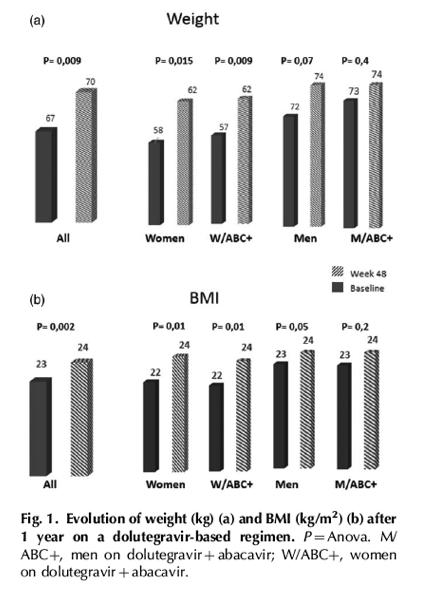| |
Dolutegravir and weight gain: an unexpected bothering side effect?
|
| |
| |
Download the PDF here
Menard, Amelie; Meddeb, Line; Tissot-Dupont, Herve; Ravaux, Isabelle; Dhiver, Catherine; Mokhtari, Saadia; Tomei, Christelle; Brouqui, Philippe; Colson, Philippe; Stein, Andreas
AIDS June 19 2017
We recently analyzed, in our real-life cohort of 2260 HIV-infected patients, the reasons for discontinuation of dolutegravir-based combined antiretroviral therapies (cARTs) [1]. Of 517 patients, 55 (10.6%) discontinued this cART due to adverse effects. Unexpectedly, four (7%) of these adverse effects were abnormal weight gain, which ranged between 4 and 12 kg. This prompted us to assess, retrospectively, the evolution of weight and BMI (kg/m2) among the 462 patients who received this cART for more than 6 months. Mean age of these patients was 50.1 years, and 65% were men. At baseline, mean CD4+ lymphocyte cell count was 591 cells/μl (range 5-2010). Most patients (94%) were already receiving cART, and plasma HIV-1 RNA was suppressed for 92% of them. Dolutegravir was mostly associated with abacavir/lamivudine (48%) or tenofovir/emtricitabine (32%) [1]. Finally, BMI was less than 18 kg/m2 (class I) for 6% of the patients, ranging between 18 and 25 kg/m2 (II) in 59%, and between 25 and 30 kg/m2 (III) in 24%, and was more than 30 kg/m2 (IV), indicating obesity, in 6%.
Mean time from baseline to weight/BMI assessments was 276 ± 79 days. At this time point, mean weight gain was 3 kg (P = 0.009) and mean BMI increase was 1 kg/m2 (P = 0.002) (Fig. 1). We observed, for 20% of the patients, a more than 10% weight increase compared with baseline, whereas a 4-10% weight increase was observed for 27% of the patients. In addition, during follow-up, in 13% of the patients, BMI increased from class II to class III, and, in 9% of the patients with class III, BMI increased toward class IV. We further found that mean increases in BMI and weight were significant for women, whereas they only showed a tendency toward significancy for men. Finally, these increases were particularly significant for women receiving abacavir/lamivudine and dolutegravir, in whom weight increased from 57 to 62 kg (P = 0.009) (Fig. 1a) and BMI increased from 22 to 24 kg/m2 (P = 0.01) (Fig. 1b).

A recent study conducted in 41 149 HIV-infected patients from the D:A:D cohort showed that a high level of BMI may be associated with serious non-AIDS events [2]. In addition, body fat changes can be deleterious to self-perception and HAART adherence [3]. Gains in central fat in HIV-positive patients were strongly associated with protease inhibitors of earlier generation. However, McComsey et al. [4]showed recently, in a large randomized ART-initiation trial including 328 patients, that central and peripheral fat changes did not differ after 96 weeks of treatment containing either two boosted protease inhibitors (including darunavir and atazanavir) or the integrase strand transfer inhibitor (INSTI) raltegravir (+1 kg/m2 in 3.8-4.7% of the patients). There are, to our knowledge, no data on the effect of other INSTIs on body composition. Nevertheless, an in-vitro study showed that, in contrast with raltegravir, elvitegravir altered adipocytes differentiation and function, although less than efavirenz [5].
Hence, our preliminary finding incites the need to monitor, in other large cohorts, the effect of dolutegravir on body weight, BMI, and fat changes at various body sites. Pharmacological assessments may be helpful to explain the more significant rise observed for BMI and weight in women on dolutegravir/abacavir/lamivudine.
|
|
| |
| |
|
|
|